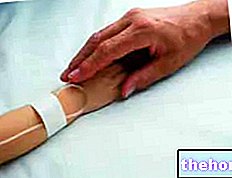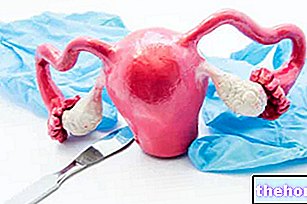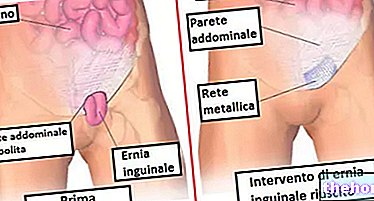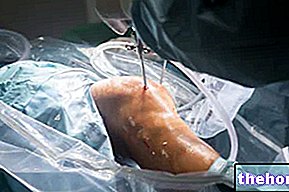Generality
The knee prosthesis is implanted when the joint, which joins the femur and the tibia, is irreparably damaged. With its application, the aim is to restore a certain joint mobility and to relieve the painful sensation, which characterizes severe knee injuries. .
Knee replacement surgery is invasive and requires appropriate rehabilitation, but the results are more than comforting. The patient, in fact, can return to lead a normal life, without particular limitations.
There are two models of knee prostheses. The choice of the most suitable model, which is up to the surgeon, is mainly based on the age and general health of the patient.
Research in the field of medical technology has a triple objective: to extend the life of the prostheses, improve implantation techniques and reduce the invasiveness of the intervention.
Brief anatomical reference: the knee
The joint, or joint capsule, of the knee is placed between the femur (located above), tibia (below) and patella (anteriorly) and is made up of several elements, all equally important in allowing movement and supporting the weight of the human body .

When is it necessary to intervene?
Like any joint in the human body, the knee joint can also be damaged. The most common symptoms are: pain, swelling and poor joint mobility.
If the damage to the joint is minor, the severity of these symptoms is modest and with the appropriate conservative countermeasures, such as physiotherapy or the use of anti-inflammatories, excellent results can be obtained.
On the contrary, when the damage is so severe that any daily activity is impossible, one must consider the hypothesis of undergoing surgery. Surgery, in fact, offers several possibilities: the knee prosthesis is one of these. the old joint, no longer functional, is replaced with an artificial one.
When to operate?
- Severe pain and swelling
- Joint stiffness and reduced knee mobility
- Difficulty carrying out the most common daily activities
- Impaired quality of life
THE MOST FREQUENT CAUSES OF JOINT DAMAGE
The most common causes, which require knee replacement surgery, are:
- Osteoarthritis. They are the most common osteoarthritis, characterized by the consumption (by continuous rubbing) of the articular cartilage. For this reason, they are also called "wear-and-tear osteoarthritis". The patient, usually elderly, experiences pain and motor difficulties.
- Rheumatoid arthritis. It is an autoimmune disease, in which the immune system, instead of defending the body from infections, "turns" against it. The consequences are the joints: they become stiff, painful and swollen.
- Haemophilia. Continuous bleeding lesions (haemarthroses) weaken the joints, which become stiff and painful. The most affected targets are the knees and ankles.
Osteoarthritis, rheumatoid arthritis and haemophilia cause progressive joint damage. Initially, it is possible to opt for a conservative treatment, aimed at relieving the symptoms. Subsequently, this therapeutic approach is no longer sufficient.

Figure: this is how osteoarthritis consumes joint cartilage. From the site: oxbridgebiotech.com
OTHER CAUSES
Other pathological conditions are also treated with prostheses, which, although less common, equally cause progressive damage to the knee.
One of these is gout, which inflames the joints due to the build-up of uric acid.
Another is avascular necrosis, due to alcohol abuse.
Yet another is represented by repeated injuries to the ligaments and hamstrings.
Finally, there are bone dysplasias and knee deformities. Both cause an anomalous arrangement of the articular bone elements, which progressively lose their mobility and integrity. They are congenital disorders, that is present from birth, with often disabling results.
HOW IS THE JOINT DAMAGED?
Osteoarthritis, and like it the other causes mentioned, cause a deterioration of the articular cartilage. Without this cartilage that protects them, the femur, tibia and patella "rub" together and wear out the (distal) extremities involved in the joint.
More or less serious damage to the cartilage can thus be observed; a young adult, for example, may have partial injuries. Therefore, each patient shows his own clinical picture, which must be carefully evaluated before intervening with a prosthesis.
WHO UNDERGOES THE INTERVENTION?
The individuals who mostly undergo knee replacement surgery are the elderly aged between 60 and 80 years. These, on the other hand, are also the most affected by osteoarthritis and rheumatoid arthritis.
The same surgery, on young adults with severe joint damage, is not the best choice. Other less invasive and more lasting solutions are preferred. As will be seen, in fact, the knee prosthesis has a duration of 15-20 years; then a second operation must be carried out for replacement; replacement, which, however, is much more complicated than the first intervention.
WHAT ARE THE FINAL OBJECTIVES OF THE INTERVENTION?
The objectives of the knee replacement surgery are:
- Pain relief
- Improvement of joint mobility
- Improvement of the motor skills of the operated individual
- Significant improvement in the quality of life
The modalities of intervention
There are two types of knee prostheses to choose from:
- Total prosthesis
- Partial or unicompartmental prosthesis

Figure: the parts that make up a total knee replacement. From the site: permedica.it
The choice depends on the severity of the joint damage: if the bone, ligament, tendon, etc. injuries are severe, total prosthesis is used; when, on the other hand, the knee still has healthy areas, a partial (or unicompartmental) prosthesis is used
TOTAL KNEE PROSTHESIS
Severe knee joint damage requires a total replacement. In fact, in these situations, osteoarthritis (or any of the other causes mentioned above) has worn down the extremities of the femur and tibia so thoroughly that they must both be replaced by artificial metal structures.
Deep and long-standing damage can also affect the patella; as a result, total prostheses were developed that are also suitable for this eventuality.
The graft of a total knee prosthesis is, by far, the most practiced procedure.
PARTIAL (OR SINGLE-COMPARTMENTAL) PROSTHESIS IN THE KNEE
When there is only one damaged or worn bone end, a partial prosthesis is applied.

From the site: adrianorusso.it
Since this is an infrequent pathological circumstance (usually the entire joint structure is affected), the partial prosthesis is rarely implanted (only one in four people with osteoarthritis). In addition, it also has disadvantages, which will be discussed later.
THE DURATION OF A PROSTHESIS
A total prosthesis lasts about 15-20 years.
A partial prosthesis, on the other hand, has a shorter life: about 10-15 years.
The pre-operative period
The period preceding the operation can be fundamental to shorten the post-operative recovery.
Walking, for example, is of great benefit, both to the muscles and to the ligaments.
Another very important recommendation is to perform some muscle and tendon stretching exercises for the lower limbs and muscle strengthening for the upper limbs. The latter, in fact, will be called to a hard work when using crutches. .
THE INSTRUMENTAL EXAMINATIONS
During the pre-operative phase, the patient undergoes various instrumental radiological and electrocardiographic examinations.
The aim is to get to know the patient thoroughly, clarifying his general state of health, the precise anatomy of the knee (the prosthesis is made to measure), etc. Acquiring this information increases the success rate of the intervention.
How do you do it? The procedure
The operation is performed by a surgeon expert in knee orthopedics, who avails himself of the help of consultants and an anesthetist. It is of fundamental importance that the operating surgeon knows the patient's clinical history and the exact anatomy of the knee on which the prosthesis will be implanted. The prosthesis, in fact, in order to function correctly, must be made to measure.
ANESTHESIA
Knee replacement surgery (both total and partial type) is usually performed under general anesthesia. However, it is also possible to opt for an epidural anesthesia, in which only the lower part of the body is numb to pain. Those who choose this second option, however, are not conscious, since they must take strong sedatives.
THE TOTAL PROSTHESIS OPERATION
Once the anesthesia has taken place, the actual operation begins. The procedure can last from one to three hours and includes three key moments:
- Incision at the patella
- Removal of worn bone ends of the femur and tibia
- Replacement with artificial joint
The incision is made where the patella resides, which is moved to one side, to have free access to the entire joint implant of the knee. At this point, we proceed with the removal of the worn ends of the tibia and femur and with their replacement with metal plates.
The distal part of the femur is replaced by a curved plate; the proximal part of the tibia, on the other hand, is replaced with a flat plate.

From the site: francescobove.com
Between the two plates, which are glued to the bones with a substance called "cement", a plastic spacer element (or insert) is inserted. It plays the same role as articular cartilage, avoiding direct rubbing of the femur and tibia.
If the patella is also damaged, on the latter, a metal plate is applied on the inside.
At the end of the procedure, the incision is closed and sutured.
THE PARTIAL PROSTHESIS OPERATION
The operation involves a minor incision, compared to the previous procedure described, and the removal of a single bone portion, or of the femur or tibia.
COMPARING THE TWO PROSTHESES
The partial prosthesis is less invasive than the total one. In fact, it requires shorter healing times, since the incision is shallower and the rehabilitation process is shorter.
However, it has significant disadvantages, which lead the surgeon to opt, in most cases, for the total prosthesis.
Disadvantages of the partial denture
- It lasts less than the total prosthesis. An operation to replace the old prosthesis is very problematic, much more than the first operation. For example, the glue (or cement) used to fix the plates is very strong and it is very difficult to remove it.
- It offers fewer therapeutic benefits than a full denture. The pain, in fact, can recur after some time, as joint degeneration is a progressive process, which consumes the bone portions not yet replaced by the prosthesis.
WHICH PROSTHESIS TO CHOOSE? THE SELECTION CRITERIA
The choice of the type of prosthesis to use is up to the surgeon, who bases his considerations on the following elements:
- Age of the patient
- Basic pathology
- Body weight
Because of its importance, the age of the patient deserves special attention.
For the elderly. If the joint damage is limited, a partial prosthesis may also be suitable, the graft of which is less debilitating and invasive. In fact, although this solution is less durable, the elderly patient is unlikely to undergo a second operation to replace the worn prosthesis.
For the young or middle-aged patient. If the joint damage is severe and it has been found that there are no such effective remedies, the most suitable prosthesis is the total type. This is the only way to postpone replacement surgery for as long as possible.
CONTINUE: Knee prosthesis - Recovery after surgery, Risks and Benefits »









.jpg)


















